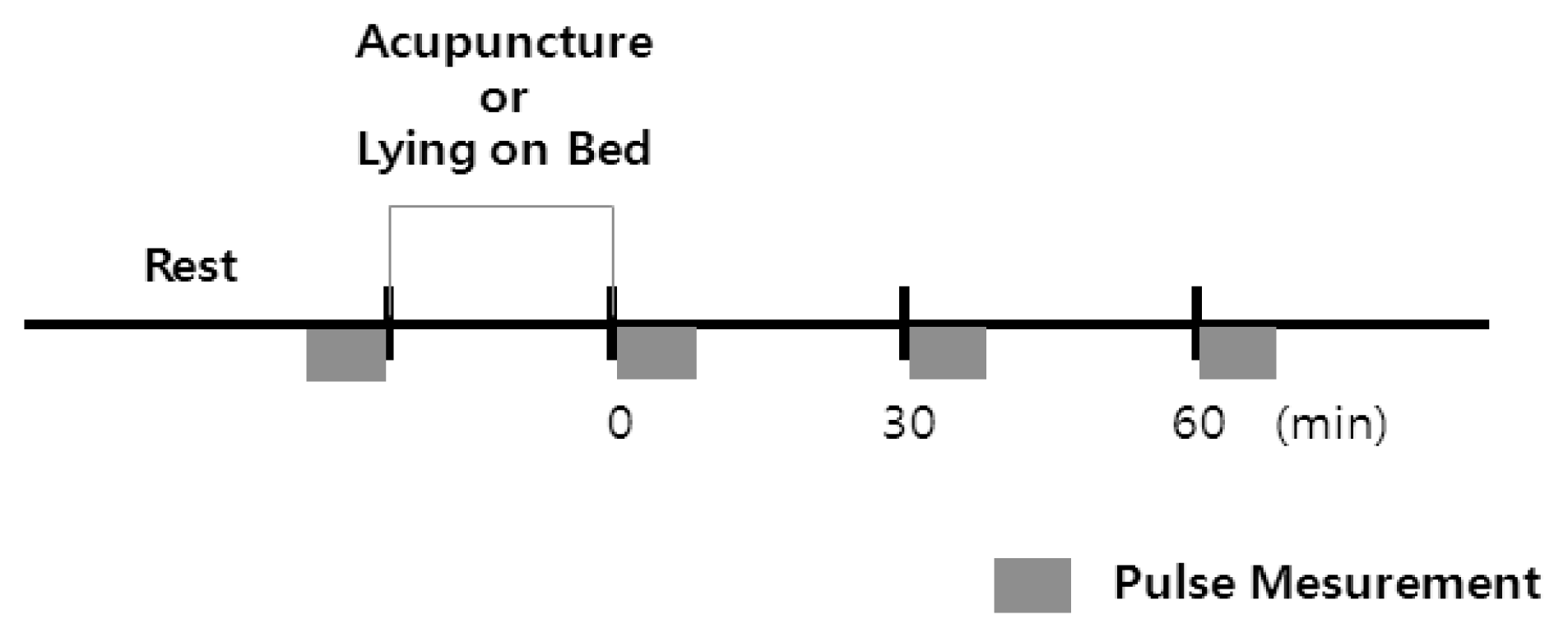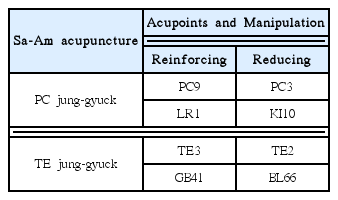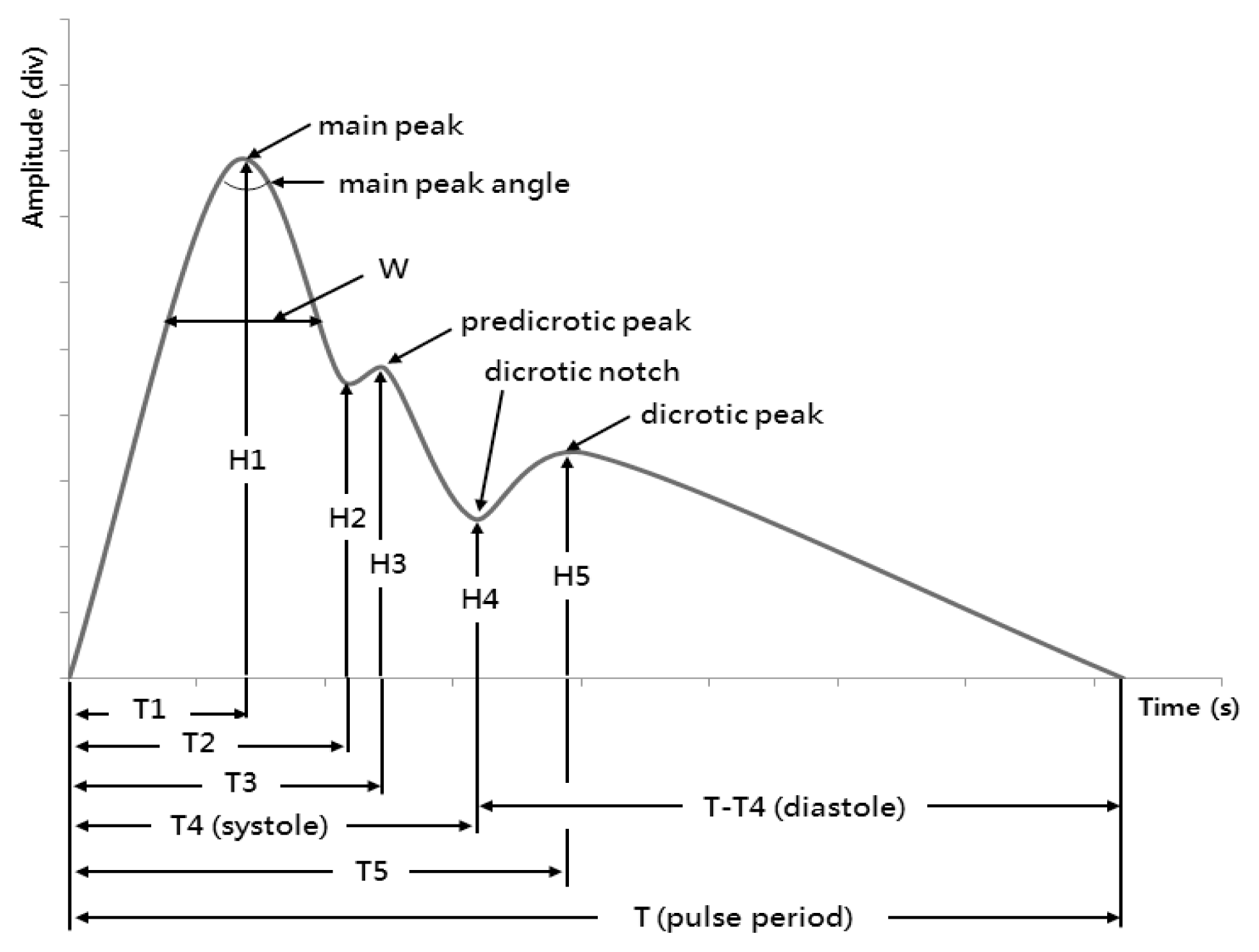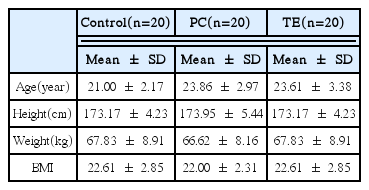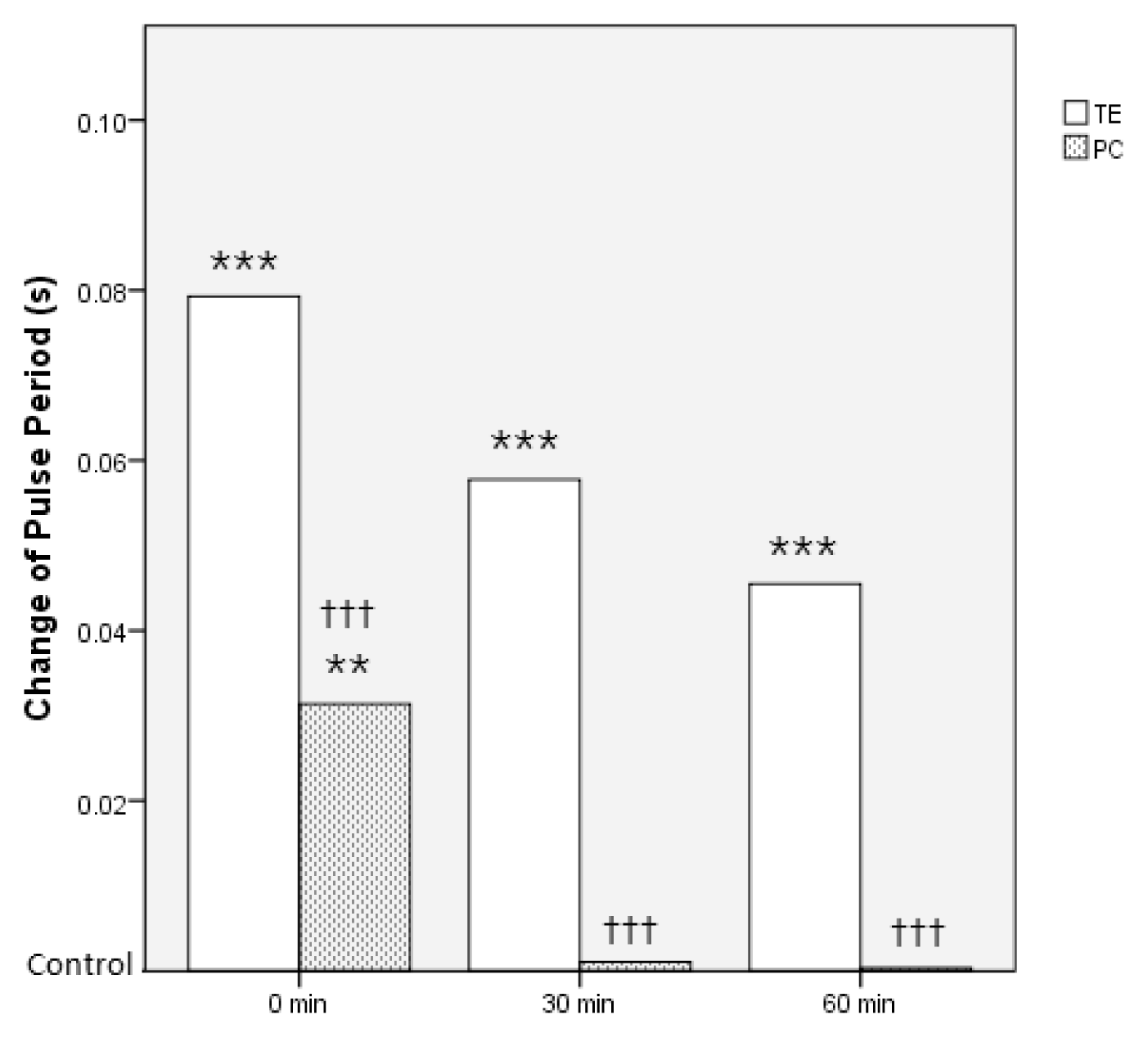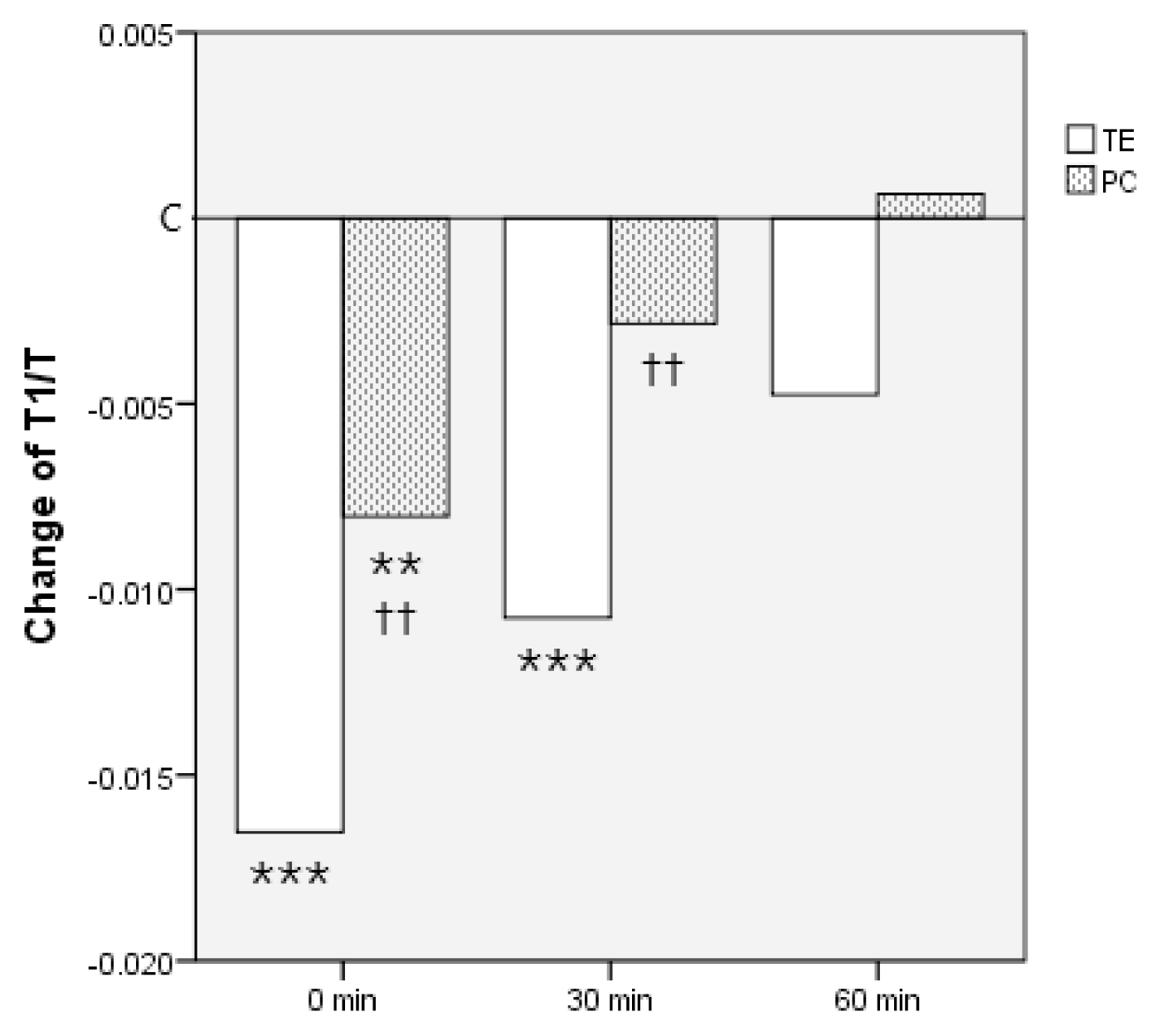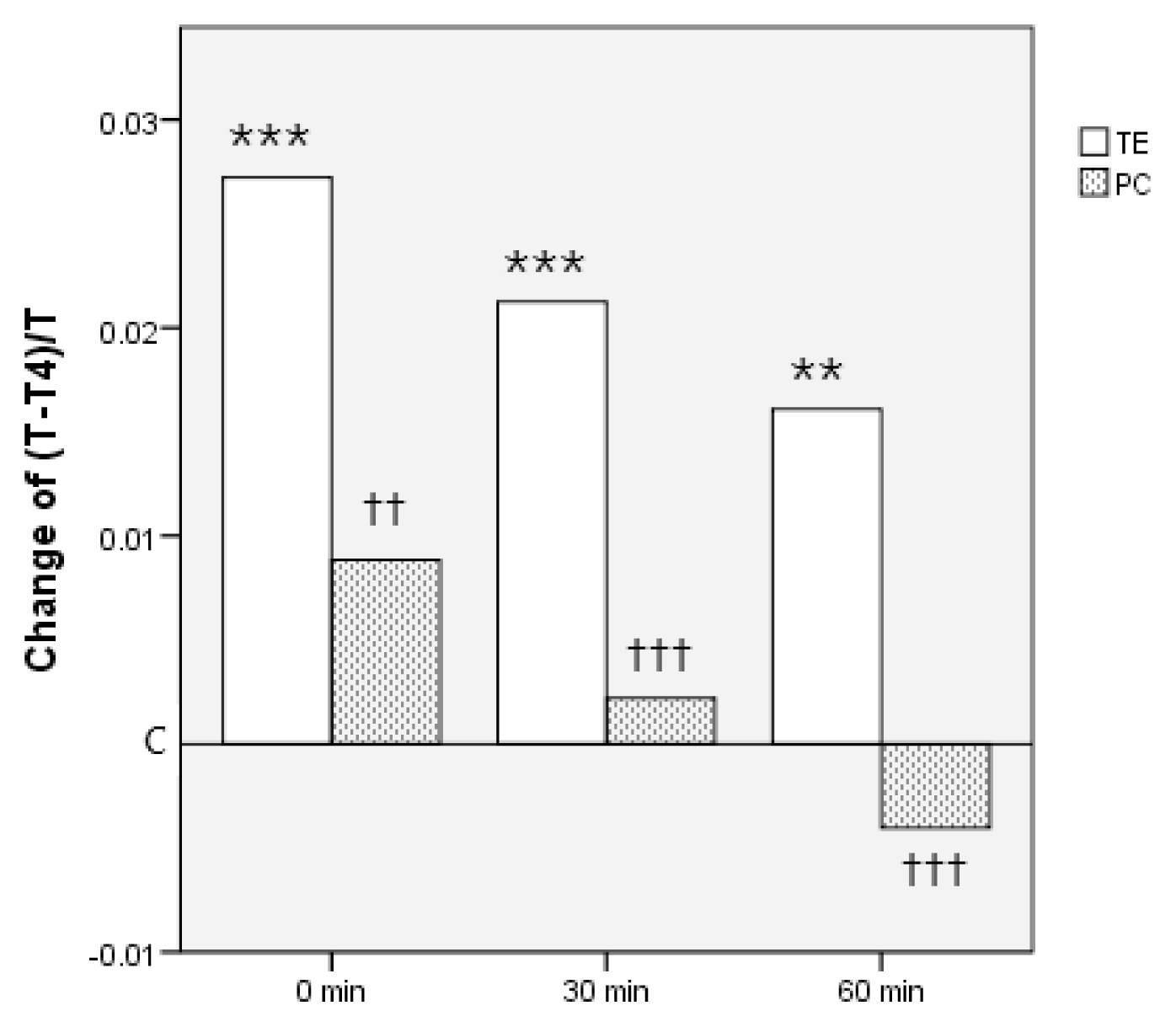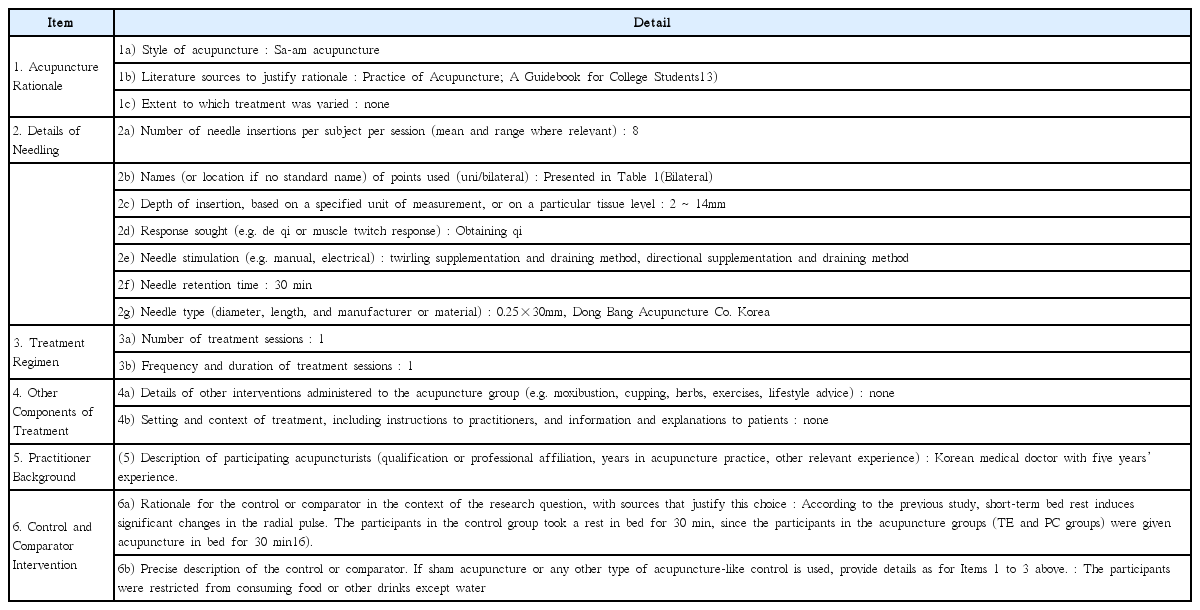The Effects of Sa-Am Acupuncture on the Radial Pulse in Healthy Human Subjects: A Comparative Study of Pericardium jung-gyuck and Triple Energizer jung-gyuck
Article information
Abstract
Objectives
The purpose of this study is to investigate the effects of Sa-am acupuncture with Pericardium jung-gyuck (SA-acu-PC) and Triple Energizer jung-gyuck (SA-acu-TE) on the radial pulse in healthy human subjects.
Methods
Sixty healthy subjects participated in this study and divided into three groups randomly: Control group(C), Pericardium jung-gyuck group(PC), Triple Energizer jung-gyuck group(TE). Radial pulse was measured by 3 dimensional pulse imaging system (DMP-3000) before, right after, 30 minutes after, and 60 minutes after acupuncture.
Results
1. The changes observed in periodic parameters are considered as the common effects of both SA-acu-TE and SA-acu-PC. SA-acu-TE was more effective than SA-acu-PC in these effects.
2. The effects of SA-acu-PC appeared in the pulse amplitude, pulse area, and pulse power volume mainly at the left chon position, and
3. The effects of SA-acu-TE appeared in the radial augmentation index and main peak angle mainly at the right gwan position.
Conclusions
The effects of SA-acu-PC and SA-acu-TE can be observed in the radial pulse. The increases in pulse amplitude, pulse area, and pulse power volume at the left chon may imply the effects of SA-acu-PC. And the decrease in the pulse power volume, the increases in radial augmentation index and main peak angle may imply the effects of SA-acu-TE.
Introduction
In Oriental medical diagnosis, the radial pulse is an important indicator of the conditions of internal organs and meridians. The pulse is examined at three different positions on the wrist, which are called chon, gwan, and cheock, bilaterally. Each position is considered to indicate the states of the corresponding organs1).
According to Oriental medical physiology, a Yin organ and a Yang organ with the same five-phases property are coupled. This coupling is called the Yin-Yang exterior-interior relationship. The pericardium and the triple energizer are in a Yin-Yang exterior -interior relationship2).
The pericardium is the outer shield of the heart. It protects the heart, prevents evil factors from infiltrating the heart, and helps spiritual stability3). The triple energizer is also known as the triple burner, triple warmer, or triple heater. Visceral qi transformation and water movement are regulated by the triple energizer2).
The pericardium and the triple energizer are coupled and have many features in common. For example, they are both involved in the movement of ministerial fire. However, their functions are opposed in some respects. For example, the pericardium supports blood circulation, while the triple energizer regulates qi transformation4).
Acupuncture is a therapeutic method that stimulates certain points on the body surface, most commonly with fine needles, in order to treat or prevent diseases. Sa-Am acupuncture is a kind of acupuncture technique initiated by a Korean physician named Sa-Am. This technique is characterized by the application of the five-phases theory and the mother-child reinforcement-reduction principle to the selection of points and needle manipulation5).
The specific technique of Sa-Am acupuncture for reinforcing the function of the corresponding organ and meridian is called jung-gyuck6). For instance, the pericardium jung-gyuck reinforces the function of the pericardium in activating the cardiovascular system and improving blood circulation. The triple energizer jung-gyuck reinforces the function of the triple energizer in activating qi transformation and in regulating the waterways2).
Pulse is affected by various factors, and is also known to be altered by acupuncture. Previous studies have shown that acupuncture induces immediate changes in pulse, and the results vary depending on the points used and the techniques applied7–11). Acupuncture influences the functions of internal organs and meridians, and the pulse indicates the physiological and pathological conditions of the body. So it can be hypothesized that the functions of the pericardium and the triple energizer will be reinforced by Sa-Am acupuncture with pericardium jung-gyuck (SA-acu-PC), and Sa-Am acupuncture with triple energizer jung-gyuck (SA-acu-TE), respectively, and consequently that the common aspects as well as the opposite aspects of the actions of SA-acu-PC and SA-acu-TE may be reflected in the pulse.
To investigate the effects of SA-acu-PC and SA-acu-TE on pulse, sixty healthy volunteers participated in this study, and their pulses were measured before and after acupuncture.
Methods
1. Subjects
Sixty healthy volunteers with no underlying diseases or prescribed medicines were randomly divided into three groups: control group, Sa-Am acupuncture group with triple energizer jung-gyuck (TE group), and Sa-Am acupuncture group with pericardium jung-gyuck (PC group).
The criteria for exclusion were as follows: arrhythmia, systolic blood pressure > 150, diastolic blood pressure < 60, wounds or scars in the region of pulse measurement, body mass index (BMI) < 18 kg/m2 or BMI > 32 kg/m2, pregnancy, women in menstruation.
All subjects provided written informed consents. This study was approved by the institutional review board of Daejeon Korean Hospital of DaeJeon University (approval no. P2012-4).
2. Experimental Procedure
The experimental procedure is presented in Figure 1. All subjects took 30 minutes of rest sitting on a comfortable chair before the experiment. The radial pulse was measured in a sitting position. After the first measurement of the radial pulse, the participants in the acupuncture groups (TE and PC groups) were given acupuncture in the supine position for 30 minutes, and the participants in the control group took 30 minutes of rest in bed. After acupuncture or bed rest, the radial pulse was measured again in the same manner as the first measurement, taking three measurements with 30-minute intervals. The participants were asked to remain calm throughout the experiment. Participants were allowed water, but were restricted from consuming food or other drinks. The experimental room was kept at a stable temperature (24–26 °C) and humidity (40–60%).
3. Acupuncture
Acupuncture was performed by one Korean Medical Doctor using disposable needles (0.25×30mm, Dong Bang Acupuncture Co. Korea). The acupoints used in the acupuncture groups are presented in Table 1. PC9 was located 0.1 cun proximally from the radial corner of the middle fingernail, on the intersection of the vertical line of the radial side of the middle fingernail and the horizontal line of the base of the middle fingernail. The other points were located according to WHO standard. All points were used bilaterally. Reinforcing manipulation was done by inserting the needles obliquely following the meridian flow, and rotating the needles clockwise. On the contrary, reducing manipulation was done by inserting the needles obliquely against the meridian flow, and rotating the needles counterclockwise13). The total acupuncture procedure including insertion, manipulation, retention and withdrawal of the needles took 30 minutes.
4. Pulse Measurement and Data acquisition
The radial pulse was measured at six different positions (bilateral chon, gwan and cheock) on the wrist. For reliable data acquisition and experimental reproducibility, the position of Gwan was marked on the skin in the first measurement. The next measurements were conducted based on this mark, thus guaranteeing that the pulse was measured at the same positions in every measurement.
The pulse was measured using a multi-step tonometry system (DMP-3000, Daeyomedi Co. Ltd., Korea). This device has an arterial tonometry sensor with an array of five piezoresistive semiconductor transducers applying multiple levels of pressure to obtain stable multiple-step pulse waveforms.
In this study, the pressure was applied at five different levels (50 g, 90 g, 140 g, 190 g and 240 g), and the pulse waves were recorded for five seconds at each level. The data at each level included five pulse waves from five piezoresistive semiconductor transducers. Therefore, 25 pulse waves were obtained from each measuring position.
5. Data analysis
1) Pulse wave selection
Among the five different pulse waves obtained at five different levels of applied pressure, the pulse waveform with the highest main peak was the most distinct and suitable to observe the pulse characteristics; therefore, it was selected as the ‘representative pulse wave’ (Figure 2).
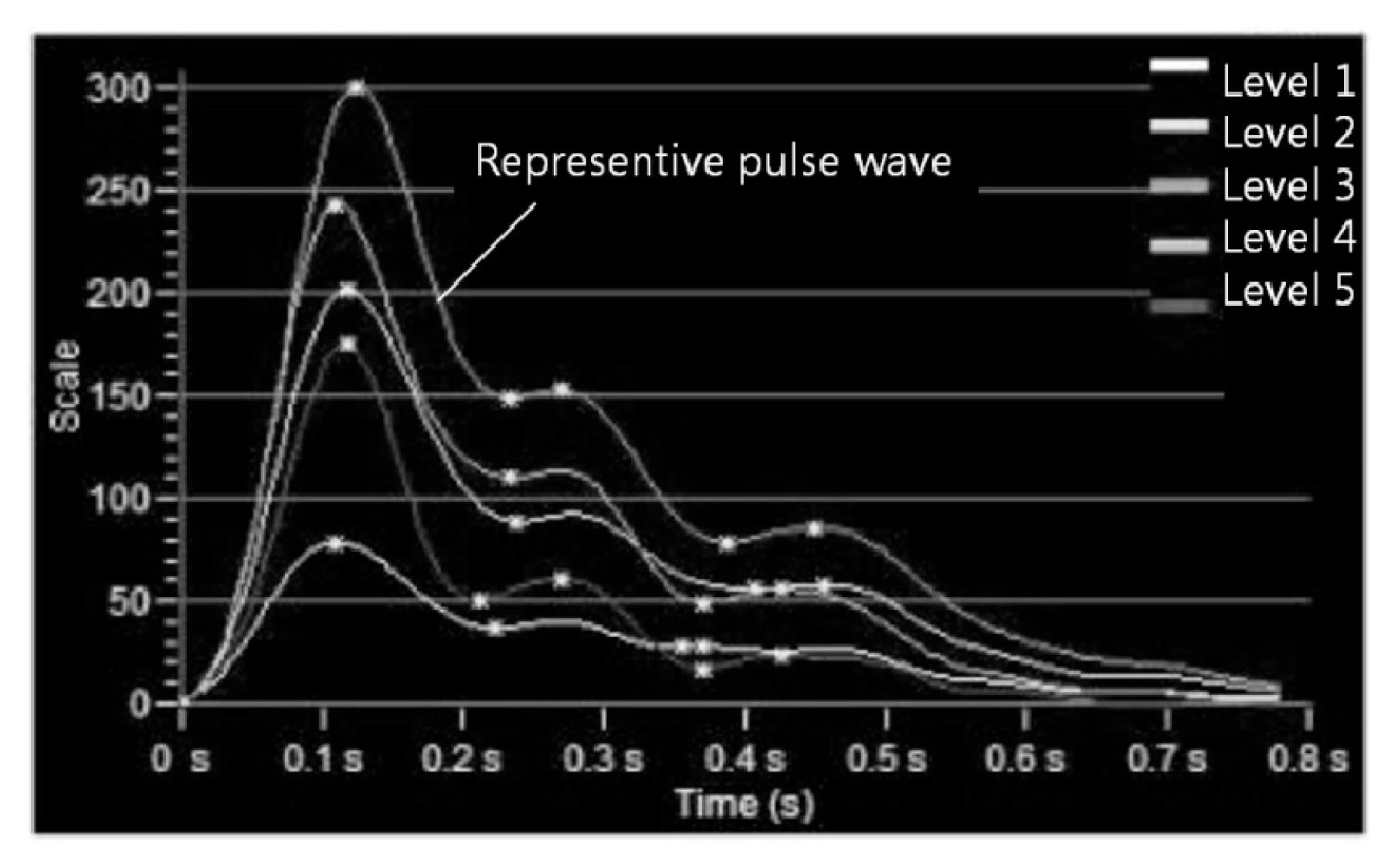
Radial pulse waveforms obtained with 5 levels of applied pressure Scale on y-axis means div (digital value for pressure).
The array sensor has five (medial, lateral, distal, proximal, and central) transducers. Among the five transducers, the central transducer is placed above the center of arterial flow. Therefore, the representative pulse wave from the central transducer was mainly analysed in this study.
2) Pulse parameters
The pulse parameters were gained by time domain analysis of pulse wave (Figure 3). Pulse power volume was estimated with the data from all of the five piezoresistive semiconductor transducers. The other parameters were obtained through the data only from the central transducer.
T : total pulse period (s)
T4/T : rate of systolic pulse period to total pulse period
(T-T4)/T: rate of diastolic pulse period to total pulse period
H1 : Amplitude of main peak
H3 : Amplitude of predicrotic peak
RAI (Radial Augmentation Index) : H3/H1
W (high-tensioned pulse period) : width of main peak where the pulse height is 2/3 of H1(s)
W/T : rate of high-tensioned pulse period to total pulse period
MPA (Main Peak Angle) : angle of main peak
Pulse Area : total pulse area estimated with pulse wave (div2)
Pulse Power volume : value estimated by integration of highest amplitudes of five representative pulses from the five transducers of the sensor (div3)
3) Statistical analysis
The statistical analysis was performed using PASW Statistics 18.0 (IBM, USA). The data of the control group were used as the baseline to analyze the effect of acupuncture on pulse parameters. The changes of each parameters were analysed using repeated measures of analysis of variance (ANOVA). Inter-group comparisons at each time point were analysed using one-way ANOVA and least significant difference (LSD) tests or Mann-Whitney U test. P values of less than 0.05 were considered statistically significant.
Results
1. Participants’ General Characteristics
There were no significant differences in age, height, weight, BMI (Table 3), and the baselines of pulse parameters (data not shown) between the groups.
2. Periodic Parameters
1) Pulse Period
The pulse period increased significantly at 0, 30, and 60 min in the TE group compared to the control group. It also increased significantly at 0 min in the PC group compared to the control group.
When compared between the PC group and the TE group, the pulse period increased significantly in the TE group compared to the PC group at 0, 30 and 60min after acupuncture (Figure 4).
2) T1/T
T1/T decreased significantly at 0 and 30 min in the TE group compared to the control group. It also decreased significantly at 0 min in the PC group compared to the control group.
When compared between the PC group and the TE group, T1/T decreased significantly in the TE group compared to the PC group at 0 and 30 min after acupuncture (Figure 5).
3) T4/T
T4/T decreased significantly at 0, 30, and 60 min in the TE group compared to the control and the PC groups (Figure 6).
4) (T-T4)/T
(T-T4)/T increased significantly at 0, 30, and 60 min in the TE group compared to the control and PC groups (Figure 7).
5) W/T
W/T decreased significantly at 0 min in the TE group compared to the control and the PC groups (Figure 8).
3. Pulse Amplitude
The pulse amplitude of the PC group increased significantly at 0 min on L1 position, at 60 min on L1 and L2 positions compared to that of the TE group (Figure 9).

Effects of Sa-Am Acupuncture with Pericardium Jung-gyuck and triple Energizer Jung-gyuck on Pulse Amplitude at each Measuring Position
Change in H1 at each time point on different measuring location was analyzed. Data were expressed as mean.
L1: left-Chon, L2: left-Gwan, L3: left-Cheock, R1: right-Chon, R2: right-Gwan, R3: right-Cheock.
C: control group, White column: TE group, Gray column: PC group.
†: p<0.05 vs TE
4. Pulse Area
Pulse area increased significantly at 0 min on L1 position in the PC group compared to the control group.
When compared between the PC group and the TE group, the total pulse area of the PC group increased significantly at 0 and 60 min on L1 position compared to that of the TE group (Figure 10).
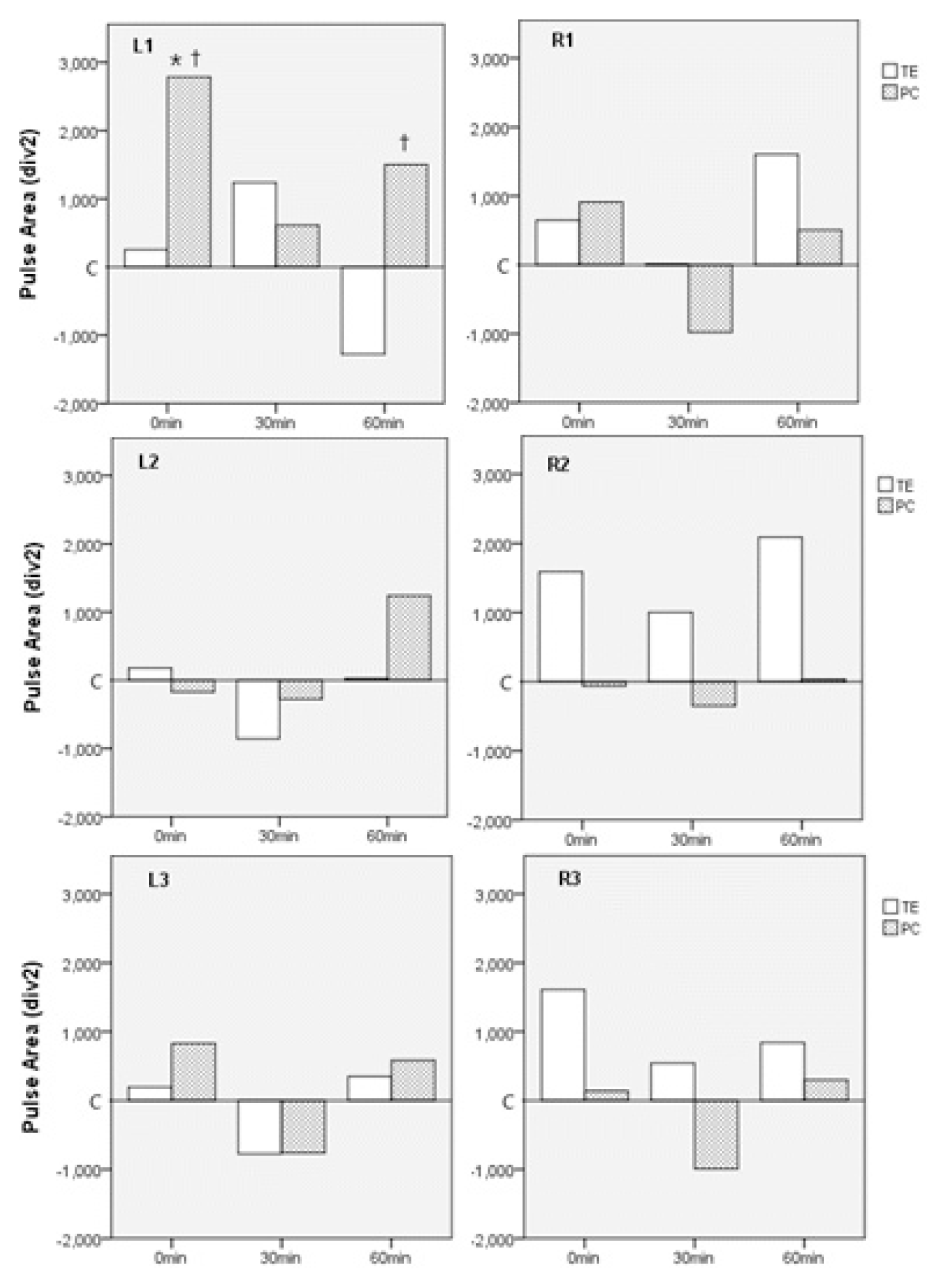
Effects of Sa-Am Acupuncture with Pericardium Jung-gyuck and triple Energizer Jung-gyuck on Pulse Area at each Measuring Position
Change in the total pulse area at each time point on different measuring position was analyzed. Data were expressed as mean. L1: left-Chon, L2: left-Gwan, L3: left-Cheock, R1: right-Chon, R2: right-Gwan, R3: right-Cheock.
C: control group, White column: TE group, Gray column: PC group.
*: p<0.05 vs control
†: p<0.05 vs TE
5. Pulse Power Volume
The pulse power volume decreased significantly at 0 and 30 min on R1 position, at 0 min on R2 position in the TE group compared to the control group.
When compared between the PC group and the TE group, the pulse power volume of the PC group increased significantly at 0 and 60 min on L1 position compared to that of the TE group (Figure 11).
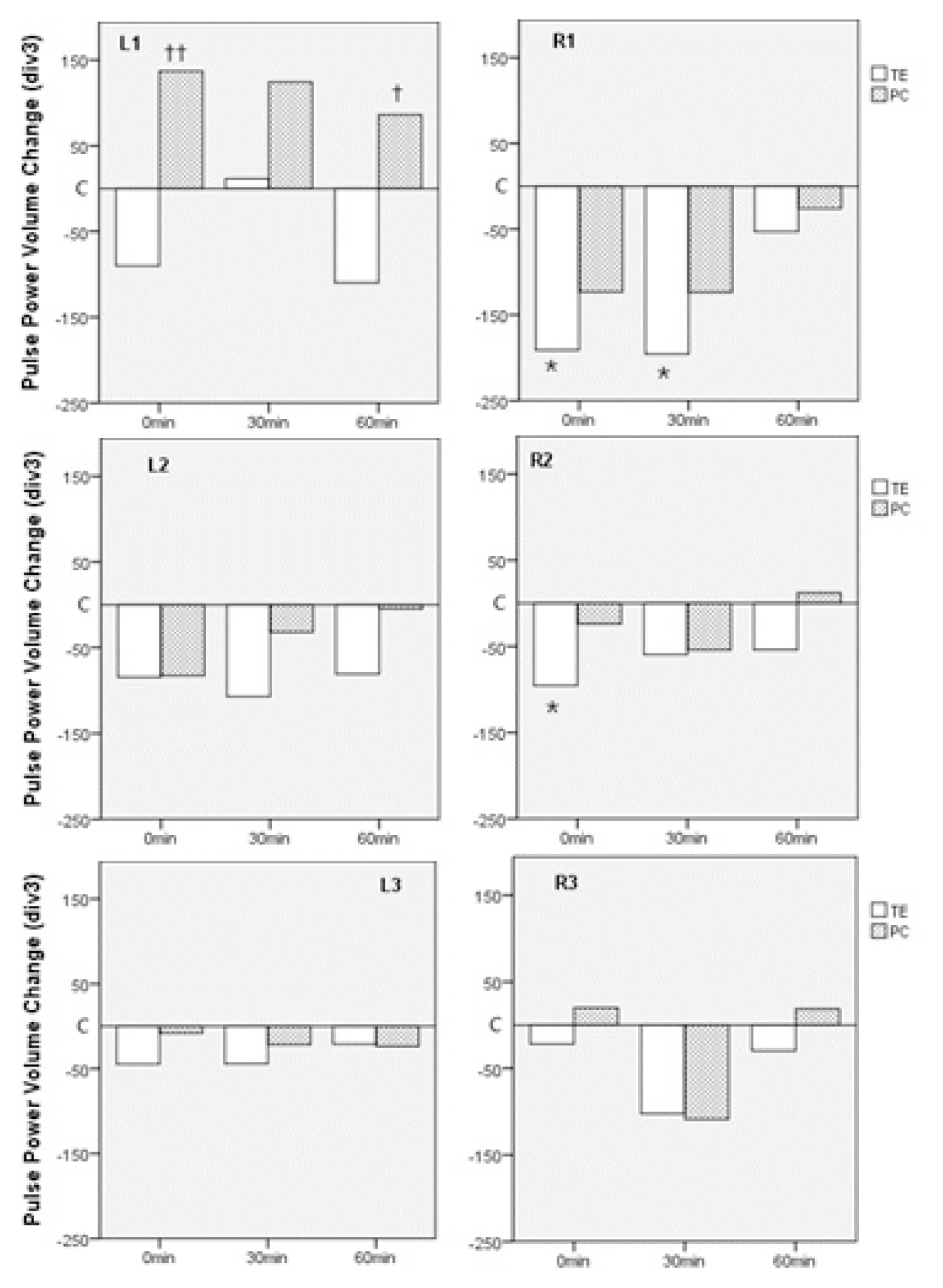
Effects of Sa-Am Acupuncture with Pericardium Jung-gyuck and triple Energizer Jung-gyuck on Pulse Power Volume at each Measuring Position
Change in the pulse power volume at each time point on different measuring position was analyzed. Data were expressed as mean.
L1: left-Chon, L2: left-Gwan, L3: left-Cheock, R1: right-Chon, R2: right-Gwan, R3: right-Cheock.
C: control group, White column: TE group, Gray column: PC group.
*: p<0.05 vs control
††: p<0.01, †: p<0.05 vs TE
6. Main Peak Angle
Main peak angle increased significantly at 0 and 60 min on R2 position in TE group compared to the control group.
When compared between the PC group and the TE group, the main peak angle of TE group also increased significantly at 60 min compared to that of the PC group (Figure 12).
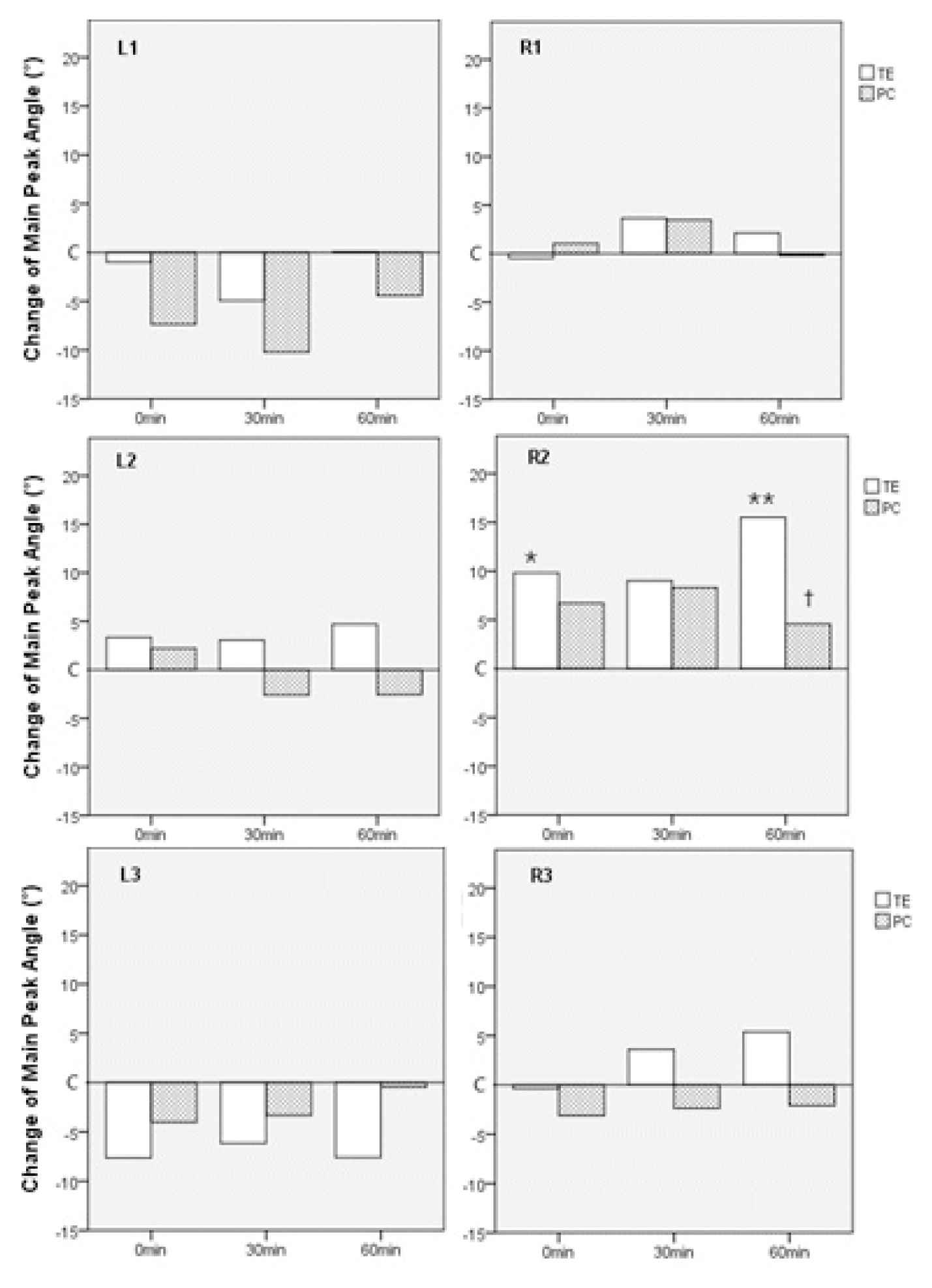
Effects of Sa-Am Acupuncture with Pericardium Jung-gyuck and triple Energizer Jung-gyuck on Main Peak Angle at each Measuring Position
Change in the main peak angle at each time point on different measuring position was analyzed. Data were expressed as mean.
L1: left-Chon, L2: left-Gwan, L3: left-Cheock, R1: right-Chon, R2: right-Gwan, R3: right-Cheock.
C: control group, White column: TE group, Gray column: PC group.
**: p<0.01, *: p<0.05 vs control
†: p<0.05 vs TE
7. Radial Augmentation Index
Radial Augmentation Index (RAI) increased significantly at 0 and 60 min on R2 position in the TE group compared to the control group.
When compared between the PC group and the TE group, the RAI of the TE group increased significantly at 0 min on R2 position compared to that of the PC group (Figure 13).
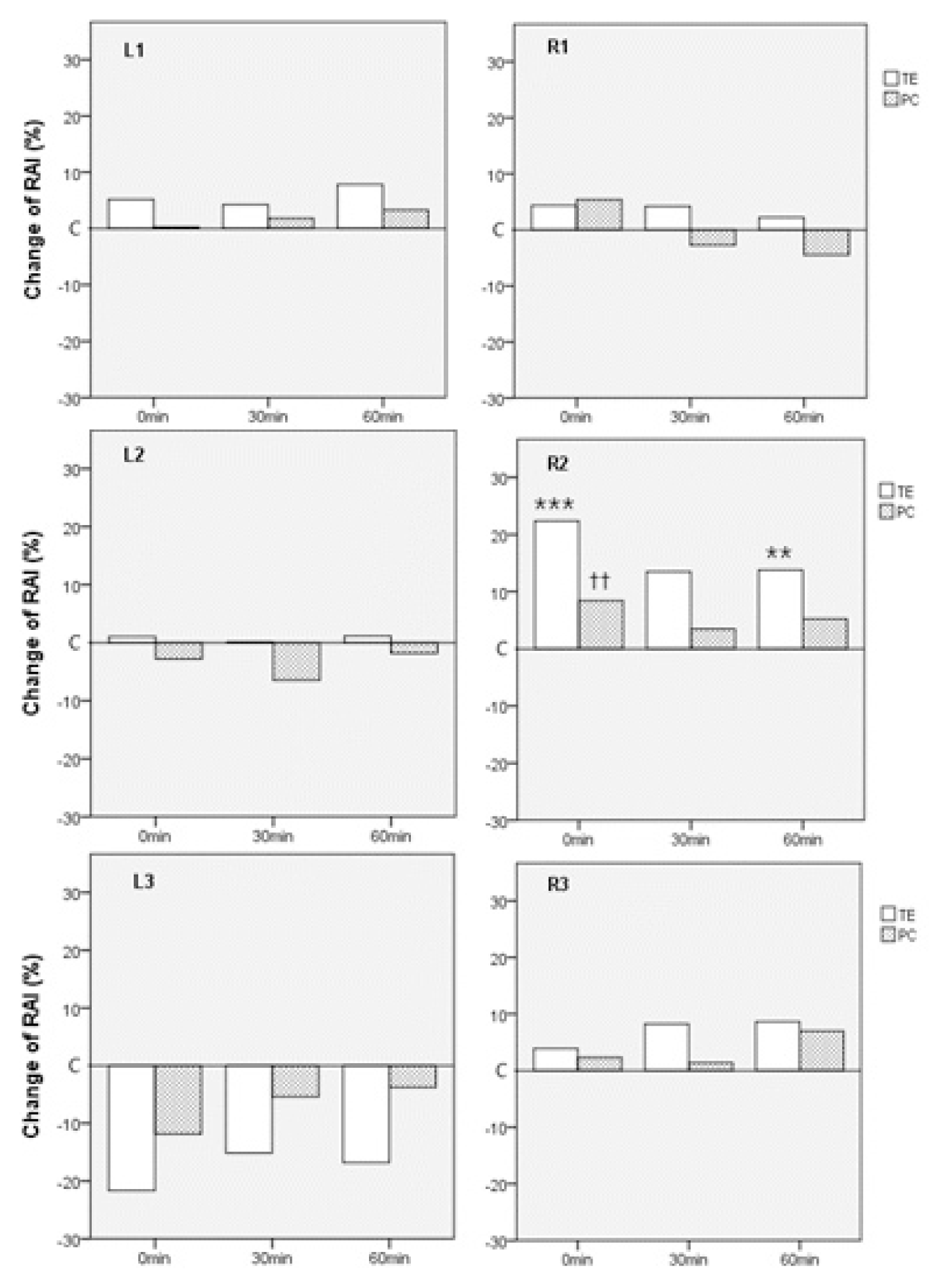
Effects of Sa-Am Acupuncture with Pericardium Jung-gyuck and triple Energizer Jung-gyuck on RAI at each Measuring Position
Change in RAI at each time point on different measuring position was analyzed. Data were expressed as mean.
L1: left-Chon, L2: left-Gwan, L3: left-Cheock, R1: right-Chon, R2: right-Gwan, R3: right-Cheock.
C: control group, White column: TE group, Gray column: PC group.
***: p<0.001, **: p<0.01 vs control
††: p<0.01 vs TE
Discussion
In Oriental medical pulse diagnosis, the radial pulse is taken at three different positions on each wrist, and the distal position is called chon, the proximal position is called cheock, and the middle position is called gwan. In terms of the theory of pulse diagnosis, the left-chon corresponds to the heart, the left-gwan to the liver, the left-cheock to the left kidney (kidney yin), the right-chon to the lung, the right-gwan to the spleen, and the right-cheock to the right kidney (kidney yang and life gate)14).
In general, the organs located in the upper body correspond to the distal positions, and those in the lower body to the proximal positions. And the pulse is also examined at different levels of depth. The superficial level correlates with the Yang organs, while the deep level correlates with their coupled Yin organs1).
In this study, Sa-Am acupuncture with pericardium jung-gyuck (SA-acu-PC), and Sa-Am acupuncture with triple energizer jung-gyuck (SA-acu-TE) were administered and the changes in pulse parameters were analyzed.
The results show that the pulse period increased in both acupuncture groups (the PC group and the TE group) compared to the control group, indicating that heart rate was decreased by both SA-acu-PC and SA-acu-TE (Figure 4). (T-T4)/T represents the rate of diastolic pulse period to total pulse period, which also increased in both the TE and the PC groups compared to the control group (Figure 7). On the other hand, T1/T, W/T, and T4/T decreased in both acupuncture groups compared to the control group (Figures 5, 6, 8). T1/T is related to cardiovascular function, and a decrease in T1/T indicates an increase in myocardial contractility15). W/T is the rate of high-tensioned pulse period to total pulse period, and T4/T is the rate of systolic pulse period to total pulse period.
Yim et al. reported that 30 minutes of bed-rest induced increases in T and (T-T4)/T and decreases in T1/T, W/T and T4/T16). In the present study, the subjects received acupuncture for 30 minutes lying on a bed as in the study by Yim et al. All the changes of the periodic parameters of T, T1/T, W/T, T4/T and (T-T4)/T in the present study were greater in extent in the TE group than the PC group (Figures 4 – 8).
It is therefore postulated that SA-acu-PC, SA-acu-TE and bed-rest acted on these periodic parameters in the same direction. In other words, SA-acu-PC, SA-acu-TE and bed-rest all reduced heart rate, increased myocardial contractility, decreased the proportion of systole and high-tensioned pulse period, and increased the proportion of diastole. It may therefore be concluded that SA-acu-PC and SA-acu-TE strengthened the effects of bed-rest. Furthermore, the increases in T and (T-T4)/T, and the decrease in T1/T, W/T and T4/T can be considered as common effects of both SA-acu-TE and SA-acu-PC. SA-acu-TE was more effective than SA-acu-PC in respect of these parameters.
Parameters for pulse amplitude and waveform were analyzed at each measuring position. H1 is the amplitude of the main peak of the pulse wave. The pulse area is the two-dimensionally estimated value of the area formed with the pulse wave. The pulse power volume is the three-dimensionally estimated value of the volume formed by the amplitudes of the representative pulse waves from the five transducers of the sensor. H1, pulse area, and pulse power volume are known to be closely related8).
In the present study, H1, pulse area, and pulse power volume all increased significantly at the left chon position in the PC group compared to the TE group (Figures 9, 10, 11). These results suggest that the increases in H1, pulse area, and pulse power volume at the left chon position may be caused by the features of the pericardium or by the effects of SA-acu-PC.
On the other hand, H1, pulse area, and pulse power volume decreased at the left chon in the TE group compared to the PC group (Figures 9, 10, 11). According to Oriental medical physiology, the pericardium and the triple energizer are coupled by Yin-Yang exterior-interior relationship, thus, their functions are common in some aspects, while opposed in other aspects. For instance, the pericardium and the triple energizer both pertain ministerial fire, while the pericardium governs blood circulation, whereas the triple energizer governs qi transformation.
In this study, the changes in H1, pulse area, and pulse power volume at the left chon in the TE group were mostly the opposite to those in the PC group. Therefore, it can be suggested that the changes in H1, pulse area, and pulse power volume at the left chon may be considered as possible indicators for investigating the different properties of the pericardium and the triple energizer, and also the different effects of SA-acu-PC and SA-acu-TE.
In addition to the left chon, H1 increased significantly at the left gwan in the PC group compared to the TE group (Figure 9). The left gwan corresponds to the liver, and the foot reverting yin liver meridian correlates with the hand reverting yin pericardium meridian. It is assumed that SA-acu-PC influenced not only the pericardium but also the liver which is related to the pericardium.
With regard to triple energizer jung-gyuck (SA-acu-TE), the pulse power volume significantly decreased at the right chon and the right gwan in the TE group compared to the control group (Figure 11). Moreover, the main peak angle (MPA) and radial augmentation index (RAI) increased significantly at the right gwan in the TE group compared to the control group or the PC group (Figures 12, 13).
From these results, it may be postulated that the decrease in pulse power volume at the right chon and the right gwan, and the increases in RAI and MPA at the right gwan may be caused by the features of the triple energizer or by the effect of SA-acu-TE.
In the theory of Oriental medical diagnosis, the left pulse is related to blood and the right pulse is related to qi. As mentioned earlier, the pericardium supports blood circulation, while the triple energizer governs qi transformation. Thus, the triple energizer is more likely to correspond to right side of the radial pulse than to the left side.
The triple energizer is also called the triple burner, because it burns in three areas of the body, upper, middle, and lower. The upper burner warms the heart and lungs, the middle burner warms the spleen and stomach, and the lower burner warms the liver and kidneys. It might be difficult, therefore, to determine the corresponding pulse position for the triple energizer among the three positions of chon, gwan, and cheock. However, taking into account the overall results of this study, the effects of SA-acu-TE seem to appear mostly at the right gwan.
Since the effects of SA-acu-TE appeared mainly at the right gwan, it is also possible to assume that the effects of SA-acu-TE appeared mainly on the right gwan because the technique of SA-acu-TE might have affected the middle energizer more than the upper or lower energizers, even though the upper, middle, and lower energizers correspond to the right chon, gwan, and cheock respectively.
As for the correspondences of internal organs to pulse positions, the pericardium and the triple energizer have no corresponding positions in terms of the general principles of Oriental medical pulse diagnosis.
According to the general correspondences, the deep level of the left-chon corresponds to the heart, and the superficial level of the left-chon corresponds to the small intestine which is in Yin-Yang exterior-interior relationship with the heart. However, several classics such as 『Zhang Jie bing’s complete book (景岳全書)』 and 『Required Readings for Medical Professionals (醫宗必讀)』 correlate the deep level of the left-chon with the heart17), and the superficial level of the left-chon with the pericardium which is the outer shield of the heart18). Both opinions are prima facie theoretically reasonable. However, the results of the current study seem to agree with the latter, in that H1, pulse area, and pulse power volume increased at the left chon position by SA-acu-PC.
In addition, since the triple energizer regulates qi transformation and burns fire in the upper, middle, and lower body cavities, it may correspond to all the three positions of chon, gwan, and cheock on the right-hand side. However, the present study shows that the right gwan responded most when stimulated with SA-acu-TE. It remains uncertain whether the right gwan is the only corresponding position for the triple energizer, or whether the right gwan responds only in case of Sa-Am acupuncture and the right chon or the right cheock would respond in other cases.
The correspondences of the pericardium and the triple energizer to pulse positions is not clear yet. Further studies on this issue will be needed in the future.
Human body maintains homeostasis through various mechanisms, and it is natural that changes in human body induced by external stimulus tend recover back to the previous states gradually over time. In the present study, the changes in pulse parameters mostly appeared right after acupuncture and diminished gradually over time. However, some parameters started to change with some time interval after acupuncture, and some changes were magnified even more over time.
For instance, no significant change in H1 at the position of left gwan was found right after nor 30 min after SA-acu-PC, but a significant increase was found 60 min after SA-acu-PC (Figure 9). As mentioned earlier, the left gwan corresponds to the liver, and the foot reverting yin liver meridian correlates with the hand reverting yin pericardium meridian. We assumed that SA-acu-PC influenced not only the pericardium but also the liver which is related to the pericardium, and it might take some time to transfer the influence from the corresponding organ and meridian to the related organs and meridians.
In addition, the main peak angle at the right gwan position increased significantly right after SA-acu-TE, and then increased even more 60 min after SA-acu-TE (Figure 12). We assume that there may exist a mechanism to amplify the therapeutic stimulus to achieve the desired therapeutic effect in human body. It may be how a tenuous stimulus by a fine acupuncture needle induces a tremendous therapeutic effect to treat disease.
The present study was carried out on healthy subjects, using Sa-am acupuncture with pericardium jung-gyuck, and triple energizer jung-gyuck, and analyzed the parameters mainly of the representative pulse wave gained from the central transducer. Further studies are expected to be conducted on subjects with various conditions, using various acupuncture techniques other than Sa-Am acupuncture, or various specific techniques of Sa-Am acupuncture other than jung-gyuck (such as seung-gyuck, han-gyuck and yul-gyuck), and analyzing various pulse parameters from all pulse waves at different pressure levels.
Conclusion
The effects of acupuncture on the pulse were investigated using Sa-Am acupuncture with pericardium jung-gyuck (SA-acu-PC) and Sa-Am acupuncture with triple energizer jung-gyuck (SA-acu-TE) in sixty healthy volunteers and the results were as follows.
The changes observed in periodic parameters may be considered as the common effects of both SA-acu-TE and SA-acu-PC. SA-acu-TE was more effective than SA-acu-PC in these effects.
The increases in pulse amplitude, pulse area, and pulse power volume at the left chon may imply the features of the pericardium and the effects of SA-acu-PC.
The decrease in pulse power volume, and the increases in radial augmentation index and main peak angle may imply the features of the triple energizer and the effects of SA-acu-TE.
The effects of SA-acu-PC appeared mainly at the left chon position, and the effects of SA-acu-TE appeared mainly at the right gwan position.
